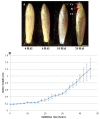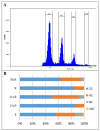Germination and the Early Stages of Seedling Development in Brachypodium distachyon
- PMID: 30257527
- PMCID: PMC6212949
- DOI: 10.3390/ijms19102916
Germination and the Early Stages of Seedling Development in Brachypodium distachyon
Abstract
Successful germination and seedling development are crucial steps in the growth of a new plant. In this study, we investigated the course of the cell cycle during germination in relation to grain hydration in the model grass Brachypodium distachyon (Brachypodium) for the first time. Flow cytometry was performed to monitor the cell cycle progression during germination and to estimate DNA content in embryo tissues. The analyses of whole zygotic embryos revealed that the relative DNA content was 2C, 4C, 8C, and 16C. Endoreplicated nuclei were detected in the scutellum and coleorhiza cells, whereas the rest of the embryo tissues only had nuclei with a 2C and 4C DNA content. This study was accompanied by a spatiotemporal profile analysis of the DNA synthetic activity in the organs of Brachypodium embryos during germination using EdU labelling. Upon imbibition, nuclear DNA replication was initiated in the radicle within 11 h and subsequently spread towards the plumule. The first EdU-labelled prophases were observed after 14 h of imbibition. Analysis of selected genes that are involved in the regulation of the cell cycle, such as those encoding cyclin-dependent kinases and cyclins, demonstrated an increase in their expression profiles.
Keywords: Brachypodium distachyon embryo; EdU; cell cycle; germination; replication.
Conflict of interest statement
The authors declare no conflict of interest.
Figures





Similar articles
-
Spatial distribution of epigenetic modifications in Brachypodium distachyon embryos during seed maturation and germination.PLoS One. 2014 Jul 9;9(7):e101246. doi: 10.1371/journal.pone.0101246. eCollection 2014. PLoS One. 2014. PMID: 25006668 Free PMC article.
-
Regulation of cell cycle activity in the embryo of barley seeds during germination as related to grain hydration.J Exp Bot. 2008;59(2):203-12. doi: 10.1093/jxb/erm296. Epub 2008 Feb 10. J Exp Bot. 2008. PMID: 18267947
-
Defining the Cell Wall, Cell Cycle and Chromatin Landmarks in the Responses of Brachypodium distachyon to Salinity.Int J Mol Sci. 2021 Jan 19;22(2):949. doi: 10.3390/ijms22020949. Int J Mol Sci. 2021. PMID: 33477958 Free PMC article.
-
Mannans and endo-β-mannanases (MAN) in Brachypodium distachyon: expression profiling and possible role of the BdMAN genes during coleorhiza-limited seed germination.J Exp Bot. 2015 Jul;66(13):3753-64. doi: 10.1093/jxb/erv168. Epub 2015 Apr 28. J Exp Bot. 2015. PMID: 25922488 Free PMC article.
-
Allotetraploidization in Brachypodium May Have Led to the Dominance of One Parent's Metabolome in Germinating Seeds.Cells. 2021 Apr 7;10(4):828. doi: 10.3390/cells10040828. Cells. 2021. PMID: 33917018 Free PMC article.
Cited by
-
Seed Priming and Biopriming in Two Squash Landraces (Cucurbita maxima Duchesne) from Tunisia: A Sustainable Strategy to Promote Germination and Alleviate Salt Stress.Plants (Basel). 2024 Sep 3;13(17):2464. doi: 10.3390/plants13172464. Plants (Basel). 2024. PMID: 39273948 Free PMC article.
-
Integrated Analysis of the Transcriptome and Metabolome Revealed Candidate Genes Involved in GA3-Induced Dormancy Release in Leymus chinensis Seeds.Int J Mol Sci. 2021 Apr 17;22(8):4161. doi: 10.3390/ijms22084161. Int J Mol Sci. 2021. PMID: 33920519 Free PMC article.
-
Cytogenetic Study on the Biostimulation Potential of the Aqueous Fruit Extract of Hippophae rhamnoides for a Sustainable Agricultural Ecosystem.Plants (Basel). 2020 Jul 4;9(7):843. doi: 10.3390/plants9070843. Plants (Basel). 2020. PMID: 32635436 Free PMC article.
-
Effect of High-Voltage Atmospheric Cold Plasma Treatment on Germination and Heavy Metal Uptake by Soybeans (Glycine max).Int J Mol Sci. 2022 Jan 30;23(3):1611. doi: 10.3390/ijms23031611. Int J Mol Sci. 2022. PMID: 35163533 Free PMC article.
-
Seed dressing with M451 promotes seedling growth in wheat and reduces root phytopathogenic fungi without affecting endophytes.Front Plant Sci. 2023 May 17;14:1176553. doi: 10.3389/fpls.2023.1176553. eCollection 2023. Front Plant Sci. 2023. PMID: 37265634 Free PMC article.
References
-
- Nonogaki H., Bassel G.W., Bewley J.D. Germination—Still a mystery. Plant Sci. 2010;179:574–581. doi: 10.1016/j.plantsci.2010.02.010. - DOI
-
- Ma Z., Bykova N.A., Igamberdiev A.U. Cell signaling mechanisms and metabolic regulation of germination and dormancyin barley seeds. Crop. J. 2017;5:459–477. doi: 10.1016/j.cj.2017.08.007. - DOI
MeSH terms
Substances
LinkOut - more resources
Full Text Sources
Other Literature Sources

